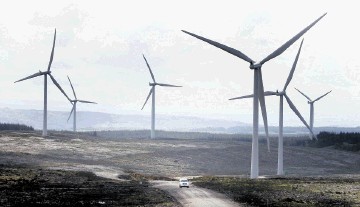
The Economy, Energy and Tourism Committee of the Scottish Parliament have asked me to submit evidence to their current inquiry into the Scottish Government’s renewable energy targets.
I wrote a 160-page report last year on “Prospects for Scotland’s Energy Industries, 2011-20” which generated a lot of debate but I need to update a few parts of that for my evidence, although not much has changed.
The main Scottish Government target is to generate 100% of our annual electricity requirements from renewable sources – hydro, onshore and offshore wind, marine energy, biomass, etc – by 2020.
There has been confusion about this target – whether it relates to actual electricity generated or capacity. The latest clarification was that it was the equivalent of 100% of electricity consumption in Scotland, which implies that the actual electricity generated would be significantly greater than domestic consumption and that the surplus renewables electricity would be exported to England or elsewhere.
I do not understand the Scottish Government’s current obsession with the electricity industry, which is a relatively small part of our energy sector and much less important than the oil and gas industry.
That may be because the Government believes it can exercise more control over the electricity industry, which may well be true. However, a key part of the SNP’s independence strategy is that Scotland would receive most of future UK oil and gas revenues, so I would expect Alex Salmond and his ministerial colleagues to give a much higher priority to the North Sea.
I may have written this before in Energy but I have little interest in the economics of electricity, in contrast to the complexities of oil and gas economics – and the excitement of foreign travel, which has taken me to Syria, Libya and Egypt most recently.
Brian Wilson, my fellow Energy columnist, clearly prefers the electricity industry but I suspect that he would have been an electrician if he had not become a successful politician and journalist.
Current energy consumption in Scotland is about 42% petroleum products, 37% gas, 18% electricity and 3% other sources. The petroleum products are mainly petrol and diesel for transport, and the gas is mainly for domestic heating.
Of the electricity, about 31% is currently generated by the Torness and Hunterston nuclear stations; around 24% from the coal-fired plants at Longannet and Cockenzie; 19% from the gas-fired power station at Peterhead, 12% hydro, 11% from windfarms and 3% from thermal renewables.
Cockenzie will close in the near future though ScottishPower intends to rebuild it as a gas-fired station. Hunterston may also close but not before 2020.
I have undertaken detailed analyses of likely future generation from all these sources and my best forecasts for 2020 are nuclear 28%, wind 18%, hydro 16%, gas 16%, coal 14%, other renewables 6% and oil 1%. The renewables share is predicted to rise from about 30% today to 40% in 2020.
However, that 40% forecast is a long way short of the Government’s 100% target. Using capacity instead of actual electricity generated would give a higher figure but there would still be a substantial shortfall.
Government spokespeople have stated that their target could still be met by a substantial increase in renewable electricity exports to England and elsewhere. We currently export about 22% of our electricity. That could increase but I am sceptical about a large rise.
I do not expect a significant increase in electricity consumption in Scotland and England over the period to 2020. The main reason is the success of energy efficiency and conservation measures. The current economic downturn has also reduced demand.
The debate about Scottish independence may not help, either. If Scotland becomes independent after the 2014 referendum, England may choose to import more, cheaper electricity from France or elsewhere. There are also plans to build new nuclear plants in England, although they would not be completed before 2020.
The Scottish Government’s renewable energy policies are laudable and I support them strongly on the whole. However, the 100% target by 2020 is unrealistic and unachievable.
Tony Mackay is the MD of energy economists Mackay Consultants
Recommended for you
